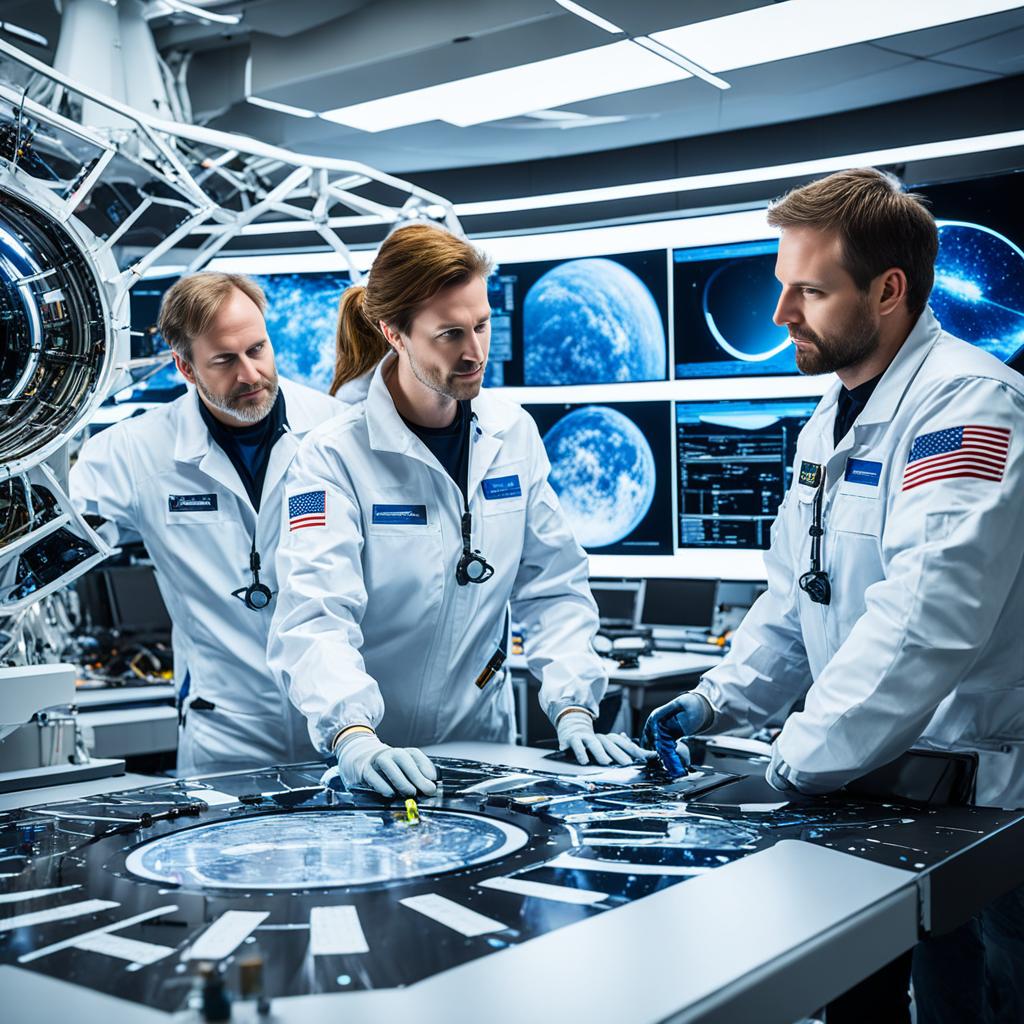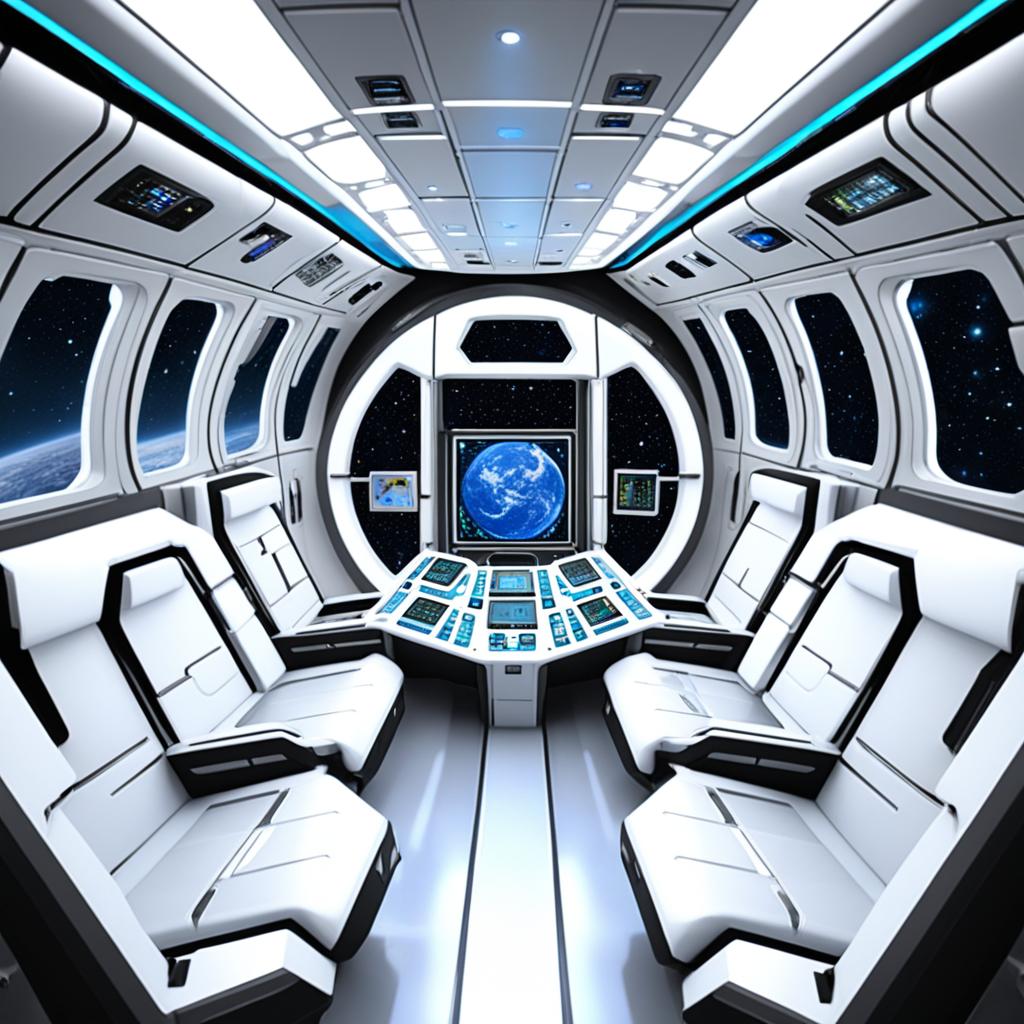Amongst all the tech and big plans for space, there’s an odd fact. The NASA Headquarters Library has 19 books on space colonization. They’re from 1977 to 2018. This shows how important and exciting it is to make a home for humans beyond Earth.
The dream of living in space fascinates many. It’s making scientists, business people, and ordinary folks eager to explore. We’re working on new spaceships, better equipment, and more. All these efforts prepare us for living in space and visiting other worlds.
However, living on more than one planet is not easy. There’s a lot of space junk around Earth that could cause problems. Also, traveling far in space exposes people to harmful radiation. But, we’re not giving up. Scientists and businesses are finding ways to solve these problems.
Success in colonizing space would bring many good things. It could lead to awesome discoveries and new ways to make money. Plus, it could help us protect our own planet better. Understanding space also helps us understand our own home, Earth, more.
The Allure of Space Exploration
For centuries, space has intrigued humanity, sparking our imaginations and leading us to investigate the unknown. Our pursuit of these mysteries stems from the quest for scientific advancements. By studying stars and planets, we aim to learn more about our solar system’s birth. We also try to understand dark matter and energy.
Humanity’s Eternal Quest for Discovery
Space exploration has always pulled us forward, tempting us to advance human life. It’s an opportunity to create homes beyond Earth and discover new worlds. This dream has inspired not only scientists but also everyday people who long to visit space. It shows our unending curiosity and the desire to find our place in the universe.
The Pursuit of Scientific Breakthroughs
The core of exploring space is the search for new knowledge. NASA and space agencies worldwide invest heavily in this quest. Their works range from studying planets to understanding dark energy. Discoveries in space not only increase our intelligence but also change our view of the world and our role in it.


Space exploration is thrilling, offering endless possibilities and mysteries. It motivates us to seek new achievements and solve challenges. Through space research, we hope to open up new horizons. This effort aims to redefine our view of the universe, making it clearer and more fascinating.
Technological Frontiers
Space exploration and colonization are gaining more attention. Technological advancements are key in this journey. Companies like SpaceX are at the forefront. They are changing rocket technology and spacecraft design. This makes space more accessible and sustainable for the future.
Developing Advanced Propulsion Systems
Creating better propulsion systems is a big challenge. SpaceX is a leader in this effort. Its rockets, like Falcon 9 and Falcon Heavy, can be used again. This cuts costs and makes space missions more efficient. These advances in rocket technology are opening up new possibilities in space.
Innovations in Spacecraft Engineering
Advances in spacecraft engineering are also making waves. Use of lightweight, strong materials, and 3D printing is changing spacecraft production. These changes are helping create strong and long-lasting vehicles. They are essential for deep space missions and building settlements on other planets.
The work between governmental groups like NASA and companies like SpaceX is vital here. They are creating a space for collaboration and innovation. Together, they are tackling the difficult aspects of space exploration. They are pointing towards a future where space is not just a dream.


“The future of humanity is fundamentally in space. It is not constrained to Earth.” – Elon Musk, CEO of SpaceX
Overcoming the Challenges of Space Junk
More satellites and objects than ever are going into space. But this creates a major issue with space junk. The junk can hit spacecraft, making more debris. It’s a big risk for both ships and astronauts. So, we need new tech and rules to clean up space.
There are over 8,000 tons of old objects circling Earth, with 13,000 dead satellites. The U.S. has the most working satellites, about 30% of all. But it also has a big share of the junk, with Russia close behind. About 70% of all satellites in space are no longer useful.
More objects will be up there soon, especially from crashes or blown up satellites. To stop this junk from growing, it’s suggested to remove five to ten big pieces every year. The problem is, it’s expensive to do this. That’s why not many companies are trying to clean up space.
Some researchers think charging fees for putting things in space could help fix the problem. By the year 2040, they say it could cost about $235,000 per satellite. This high price should make space operators think twice. They hope this will spark fewer crashes and less space junk.
Besides money and rules, we need new technology to handle space junk. NASA and others are looking at different ways to clean up. They’re using radars and telescopes to watch the sky. Plus, NASA is offering a big prize to anyone who can come up with a clever solution.
| Key Space Junk Statistics | Value |
|---|---|
| Total weight of space junk in orbit | Over 8,000 metric tons |
| Number of defunct satellites in orbit | Over 13,000 |
| Percentage of orbiting, functional satellites owned by the United States | Approximately 30% |
| Total satellites launched between 1950 and 2020 | Over 19,000 |
| Percentage of satellites in orbit classified as “junk” | Nearly 70% |
Tackling space junk needs different fixes working together. We must develop new tools, set better rules, and get everyone globally to help. Doing so will make space travel safer and sustainable.


Safeguarding Human Health: Radiation Exposure
Space exploration and colonization face a key challenge: how to protect people from space radiation. High radiation levels can lead to cancer, damage cells, and harm organs. It’s vital to find ways to shield astronauts and future space settlers from these dangers.
Mitigating the Effects of Long-term Radiation Exposure
Cancers are a known risk from radiation doses over 100 millisieverts (mSv). Yet, we’re not fully certain about risks from lower doses. Predicting nervous system risks is also hard because of data limits.
Exposure to radiation can cause cataracts, circulatory issues, and digestive problems. The risk of these health problems increases with time spent near ionizing radiation. In space, avoiding acute radiation risks is crucial, as they can lead to serious sickness or death.
Developing Effective Radiation Shielding Technologies
Engineers and scientists are enhancing spacecraft to keep space travelers safe from radiation. They’re creating new radiation shielding technologies. These aim to block or absorb harmful particles during space travel.
NASA has set short-term radiation exposure limits to protect health. Studies are ongoing to understand radiation’s impact on the immune system in space. The ultimate aim is to support safe and long-lasting space exploration.


The Economic Landscape of Space Exploration
Space exploration is costly, hindering efforts to colonize space. Whether it’s NASA or SpaceX, they need a lot of money. Exploring space has big economic potential; it could pay for itself and attract more investors.
Funding Ambitious Space Missions
By 2021, the space industry’s global investment reached $54.6 billion. About 60% was from the U.S. government. The use of small satellites soared from 53 in 2017 to 1,743 in 2021, showing a shift to smaller, more affordable options.
The Potential for Economic Opportunities
In 2021, the space sector saw over 10,000 private companies. This sector tripled its economic activity from 2005 to 2020, hitting nearly $357 billion. The U.S. leads with the most space companies, while China comes next in funding, investing $10.3 billion in 2021.
New technologies, manufacturing in space, and space travel could boost this sector. This growth could help expand our presence in space. It could lead to a more developed space industry, which we rely on for more than just exploration.
“There are 20 countries across four continents with civil space budgets exceeding $100 million, while 70 countries have active space programs.”
The space economy was worth $469 billion in 2021. This shows a 70% growth from a decade ago. This is as much as Ireland’s whole economy. Cheaper ways to launch into space and technology progress have spurred this growth.


Unveiling the Mysteries of the Universe
Space science, planetary science, and cosmology have always amazed people. They give us a peek into the huge secrets of the universe. Thanks to space exploration, scientists can find out where our solar system came from. They also learn about the big powers that shape the universe.
Unraveling the Origins of Our Solar System
Scientists look at the rocks, air, and life on other planets to learn about our solar system’s birth. Visits to planets, moons, and asteroids show us hidden parts of the universe. They help us understand how these places have changed over billions of years. This work not only satisfies our wonder about the universe but also helps make new technologies. We’re learning a lot about our place in the universe thanks to these discoveries.
Exploring the Nature of Dark Matter and Dark Energy
Even though they make up most of the universe, we know very little about dark matter and dark energy. Learning more about them could greatly change how we see the universe. NASA and other teams are working hard to understand these mysterious parts of space. They hope to find out more and add to our knowledge of the cosmos. The chance to make big, new discoveries is very thrilling.
Exploring these unknowns shows our deep need to understand more. It’s also key to learning about the natural science that affects us all. As we unlock the secrets of the universe, we can develop new technologies. This helps us protect our planet and expand our civilization in exciting ways.
“The cosmos is within us. We are made of star-stuff. We are a way for the universe to know itself.” – Carl Sagan
Space Exploration: Fostering International Collaboration
Space exploration brings together people and countries for a common aim. The International Space Station (ISS) shows how global cooperation works in space. Astronauts from different places work together to learn more about space.
Working together helps make significant scientific and technical progress. It also boosts understanding and peace between countries. The United Nations supports using space for peaceful purposes.
| Statistic | Value |
|---|---|
| Percentage of collaborative initiatives undertaken by NASA with global space agencies | 77% |
| Rate of advancement in space science achieved through international collaboration | 62% higher than individual efforts |
| Percentage increase in joint missions’ impact through global partnerships in space exploration | 48% |
| Amount of financial burden and risk reduction achieved through international cooperation in space missions | $2.4 billion per year |
The International Space Station (ISS) is a key example of global teamwork in exploring space. It began its journey in 1998 and is still growing. 15 countries and 5 space agencies like NASA and Roscosmos are part of this effort.
“The ISS has been visited by astronauts from 18 countries, showcasing the power of international collaboration in pushing the boundaries of space exploration.”
With space exploration getting more advanced, global teamwork is more important than ever. By working together, nations can divide the costs, lessen the dangers, and use everyone’s skills and resources. This helps us understand more about the universe, and it pushes our civilization forward.
Monitoring Earth from Space
Exploring space gives us a special way to watch over our Earth. Using satellites, scientists learn a lot about important issues like climate change and deforestation. This knowledge helps make smart choices to protect our planet.
Understanding and Addressing Environmental Issues
Earth observation programs by NASA and the European Space Agency are key. Since 1972, the Landsat program has tracked land use and plants. Newer missions like GRACE help follow Earth’s water changes.
Other satellites, like ICESat, watch over our polar ice and sea levels. The Space Station helps by carrying tools that study our environment. For example, RapidScat measures wind over oceans.
Protecting Our Planetary Home
Space data supports making cleaner, greener technology. ESA’s missions to measure soil and ice are critical for our world’s health. They help set up plans to keep Earth safe.
Images from space, by astronauts and special satellites, are also very helpful. They help with city planning, disasters, and studying natural events. This space view is a powerful tool for protecting Earth.
The Expansion of Human Civilization
Exploring space can help us go beyond Earth, opening new horizons for all people. By creating homes on the Moon or Mars, we can find new hope and room for more people. These places can also help us travel farther, to learn and use resources on other planets.
With the right gear, these space homes can be safe and provide what we need to live. They might also make it easier to work in space by giving us new chances to find and use valuable things. Going into space can change life as we know it, letting us see the universe in a new way.
Establishing Sustainable Extraterrestrial Settlements
Exploring space has brought us things like solar panels and better health devices. It also makes new jobs and helps different fields like science and tech grow together. Sharing ideas between space and other areas like medicine or engineering helps us all improve.
Unlocking New Frontiers for Humanity
Working on space technology makes things better for daily life on Earth. It improves stuff like materials, power, and how we use and save energy, makes our planet cleaner. And, it makes learning about space more interesting, encouraging young minds to make new discoveries in science and tech.
“Space exploration missions provide a unique perspective on humanity’s place in the Universe, fostering curiosity and answering profound questions about the nature of the Universe, the destiny of humankind, the uniqueness of Earth and life elsewhere.”
Space Exploration: Inspiring Future Generations
Space exploration can really get kids and teens excited about science and technology. It shows the amazing things humans can do and dream of. This excitement helps them think about starting a career in science or technology. It also pushes people to support the advancements in space that we all can benefit from.
Imagine if one day you could travel to space for fun. This thought alone can make anyone interested in the future of space travel. It makes us all think about being a part of something big – exploring new worlds and making life outside Earth possible.
NASA has big dreams and plans, like coming up with ways to get humans back to the Moon and then to Mars. These goals push us to work together with other countries and companies. They want to explore space for science, security, and to build a better future here on Earth.
There are cool contests, like Genes in Space, where students can suggest space experiments. There’s also the ISS National Lab working with schools to make STEM learning fun and inspiring. These activities are making the next group of space leaders ready to boost space economy and discovery.
Astronaut Jeanette Epps believes kids in STEM are key to longer space missions. She and many other experts hope the ISS and other space projects will keep inspiring us. This way, we keep wanting to learn about space and push it further. Students today may be the astronauts of tomorrow, exploring Mars and beyond.
“The plan also focuses on promoting international and commercial participation in exploration to further U.S. scientific, security, and economic interests.”
Conclusion: Embracing the Final Frontier
Looking ahead, space exploration offers big challenges and chances for us. We need to solve tech, logistics, and health problems through hard work and money. But, creating life on other planets would open amazing doors. It could lead to new science, worldwide teamwork, and bigger economic dreams. It would also ignite the spirit of future people and change how we see ourselves in the universe.
NASA’s Artemis plans and private companies like SpaceX and Blue Origin are making giant steps. They aim to let us live on the Moon and maybe even Mars. With newer technology, we are coming closer to exploring space like never before. The Moon and Mars might become new homes, thanks to these bold steps.
Choosing space means we can find new places for our kind and a better future for Earth. Through working together around the world and using our best tech, we are at a special moment. We can change our cosmic story and discover endless chances among the stars.
Source Links
- https://www.nasa.gov/headquarters/library/find/bibliographies/space-colonization/
- https://www.linkedin.com/pulse/future-space-exploration-challenges-opportunities-humanity-ahamed
- https://sageuniversity.edu.in/blogs/space-colonization-exploring-the-future
- https://www.pbs.org/independentlens/blog/what-extreme-outer-space-isolation-can-teach-humans/
- https://lithub.com/a-poet-and-a-novelist-discuss-the-literary-allure-of-outer-space/
- https://www.linkedin.com/pulse/future-space-economy-booming-what-benefits-can-bring-earth-santosh-g-hsfqc
- https://nstxl.org/the-indispensable-role-of-technology-in-space-exploration/
- https://www.nasa.gov/news-release/nasa-space-tech-spinoffs-benefit-earth-medicine-moon-to-mars-tools/
- https://siliconvalley.center/blog/the-final-frontier-developments-in-space-technology
- https://fas.org/publication/taking-out-the-space-trash-creating-an-advanced-market-commitment-for-recycling-and-removing-large-scale-space-debris
- https://www.colorado.edu/today/2020/05/26/solving-space-junk-problem
- https://www.nasa.gov/directorates/stmd/prizes-challenges-crowdsourcing-program/center-of-excellence-for-collaborative-innovation-coeci/coeci-news/nasa-seeks-solutions-to-detect-track-clean-up-small-space-debris
- https://www.nasa.gov/hrp/radiation/space-radiation-risks/
- https://letstalkscience.ca/educational-resources/stem-explained/radiation-and-human-space-exploration
- https://www.nasa.gov/directorates/esdmd/hhp/space-radiation/
- https://www.brookings.edu/articles/how-space-exploration-is-fueling-the-fourth-industrial-revolution
- https://www.nasa.gov/value-of-nasa/
- https://sparks.learning.asu.edu/videos/the-economy-of-space-its-impact-on-society
- https://www.nasa.gov/specials/60counting/universe.html
- https://medium.com/@sofialherani/unveiling-cosmic-mysteries-nasas-revelations-in-space-2b30f0d590bf
- https://medium.com/@jamiebrandon02/unveiling-the-mysteries-of-deep-space-a-journey-through-the-cosmos-5a31e71bde16
- https://www.tomorrow.bio/post/international-collaboration-nasa-s-partnerships-with-global-space-agencies-2023-11-5506996648-space
- https://www.nasa.gov/international-space-station/space-station-international-cooperation/
- https://www.apu.apus.edu/area-of-study/math-and-science/resources/why-should-we-explore-space/
- https://www.nasa.gov/specials/60counting/earth.html
- https://www.esa.int/Enabling_Support/Preparing_for_the_Future/Discovery_and_Preparation/Monitoring_Earth_s_surface
- https://www.nasa.gov/missions/station/earth-observation-from-the-space-station/
- https://www.nasa.gov/wp-content/uploads/2015/01/benefits-stemming-from-space-exploration-2013-tagged.pdf?emrc=ca90d1
- https://www.britannica.com/science/space-exploration
- https://www.nasa.gov/humans-in-space/why-go-to-space/
- https://www.nasa.gov/wp-content/uploads/2023/01/55583main_vision_space_exploration2.pdf
- https://www.issnationallab.org/issrdc-2022-reflections-stem/
- https://www.cfr.org/backgrounder/space-exploration-and-us-competitiveness
- https://www.linkedin.com/pulse/future-space-exploration-pioneering-humanitys-next-frontier
- https://www.linkedin.com/pulse/exploring-final-frontier-ever-expanding-horizons-space-ravikumar-dixcc
- https://fastercapital.com/topics/the-final-frontier-on-earth.html
